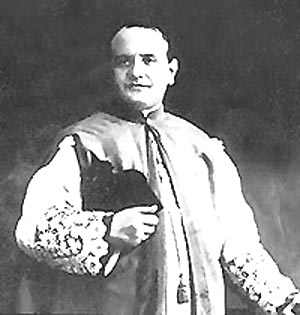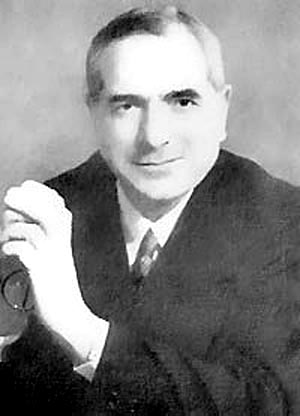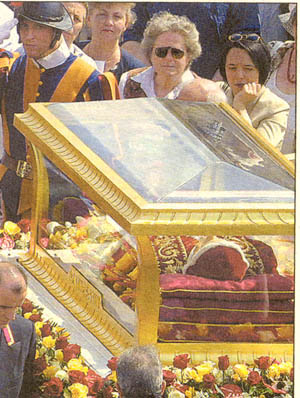 |
Consequences of Vatican II
The Incorrupt Pope and the Pharaohs
Atila Sinke Guimarães
There are many things in the life of John XXIII that raise suspicions. The young priest Angelo Roncalli had an open admiration for the Italian Modernist Ernesto Bonaiuti that did not seem to diminish with time. As Cardinal and Patriarch of Venice, he was known for his indirect political support for the socialists.

The young priest Roncalli, above, had an open admiration for Modernist Buonaiuti, below, that did not diminish with time

|
After he was chosen Pope, his actions continued to raise questions, such as, for example, his tacit abolition of Catholic militancy with his famous saying: "Communism is an enemy of the Church, but the Church does not have enemies." And there was his implicit doing away with the condemnation of heresies and the errors of paganism with the installation of ecumenism and inter-religious dialogue. Further, there was his tacit acceptance of the errors of the Nouvelle Théologie with his invitation to theologians previously condemned by Pius XII to serve as periti at Vatican II. The list is long. The readers who would like more details or documents can read footnote 14 of the Introduction in the book Animus Delendi I by the same writer who signs this column.
It did not come as a surprise to me that John Paul II should "beatify" John XXIII. Since all the items that regulated beatifications and canonizations were eliminated in the new Code of Canon Law, everything now seems left to the arbitrary personal discretion of the Pontiff. And this has not shown itself to be as rigorous as the prior requirements. More or less everywhere he is beatifying whomsoever he desires.
The following axiom seems to apply well to him on the matter: "Potuit, voluit, ergo fecit" (He was able to do it, he wanted to do it, therefore he did it.)
What did surprise me was to hear that the body of John XXIII was found incorrupt. While I know that the incorruptibility of the body of a person is not an unequivocal sign of sanctity, it would nonetheless be a strong sign. I am firmly convinced that Angelo Roncalli was not a saint either before or after his ascension to the Pontificate. Thus my surprise and my perplexity, when I received the news of the incorrupt body. "Would there be a natural cause? Or could there be something preternatural?" I didn't have elements to respond, and in my perplexity I calmly awaited an answer.
The answer reached me about 15 days ago, when I was catching up on my reading. I came upon an important report that I will summarize below. The report was published in the Italian weekly Famiglia Cristiana (n. 22, 2001) and I base myself on the information given in the French bulletin La Contre-Réforme Catholique (n. 8, August 2001).
John XXIII had chosen Professor Valdoni as his personal doctor, and the latter was assisted by Professor Mazzoni. These two doctors had heard about the discovery of a young colleague, Dr. Gennaro Goglia, assistant Professor at the Institute of Anatomy of the Faculty of Medicine at the University of the Sacred Heart in Rome. Goglia had discovered a system to keep cadavers incorrupt. The two doctors of the Pope contacted the young scientist, and when the cancer of the stomach reduced John XXIII to his final stage, they asked Goglia to be ready to apply his invention on the Pope after his death. The two doctors had already spoken with John XXIII on the matter, and the latter had given them a written document leaving them in charge of preserving his mortal remains.

The mummified corpse of John XXIII, wearing a wax mask, now remains on display in St. Peter's Basilica - Los Angeles Times, June 4, 2001 |
Therefore, as soon as he died on the evening of June 3, 1963, Goglia was contacted and brought to the Vatican. In the Papal quarters, he set up next to the cadaver a tripod that held a plastic bottle containing ten liters of his liquid preservative. He then began the process of injecting this liquid with a tube and needle into the body of John XXIII. It was a long procedure, crowned with success. Those present during the proceedings in addition to Goglia were Prof. Mazzoni and two valets of John XXIII, the Gusso brothers. Dr. Goglia provided these details to Famiglia Cristiana in the interview. Until then, the whole operation had been kept rigorously secret.
I would like to let the reader read for himself the end of the testimony of the doctor, who today is age 78. Here are his words:
"We put the bottle containing the liquid on the tripod. We made a small cut in the right wrist and inserted the needle there. I was afraid that the blood would exit through the tube or that the liquid could cause the skin to rupture .... At 5 a.m. on June 4 the operation ended. The liquid had reached all the capillaries, blocking the process of decomposition. We then injected some liters of the liquid into the Pope's stomach, destroyed by cancer, in order to kill the bacteria there."
Here is the explanation. The incorrupt body of John XXIII is due to a scientific achievement, not to a miracle that would confirm the sanctity of Angelo Roncalli. If the fact of a body remaining incorrupt would itself reveal sanctity, then the Pharaohs of Egypt that were mummified should be considered saints.


Related Topics of Interest
 A "Saint Factory" A "Saint Factory"
 Doubts about the Sanctity of John XXIII Doubts about the Sanctity of John XXIII

|
New Canonizations | Vatican II | Home | Books | CDs | Search | Contact Us | Donate

© 2002- Tradition in Action, Inc. All Rights Reserved
|
 |
|